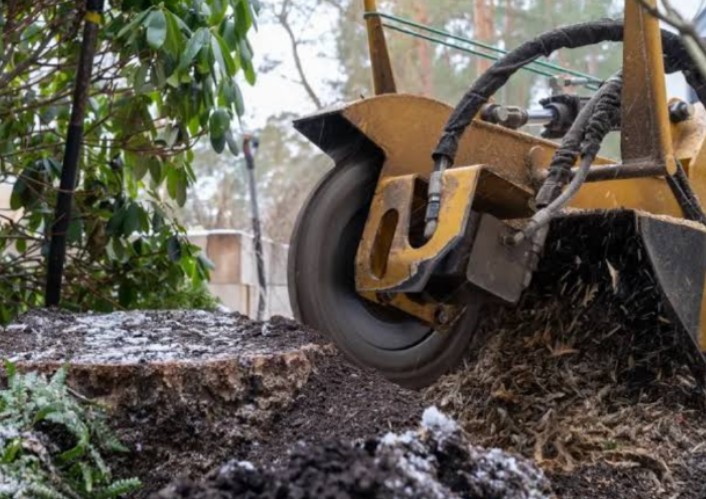In the arid landscapes of Phoenix, Arizona, where every ecological contribution counts, the practice of stump removal Phoenix holds profound significance beyond mere aesthetics. While the removal of stumps might seem like a mundane task, delving deeper reveals its vital role in fostering environmental health and sustainability.
Exploring Ecological Significance
1. Promoting Soil Health
Stumps left to decay not only harbor fungal diseases and pests but also create anaerobic conditions detrimental to soil vitality. Their removal fosters better aeration, allowing oxygen to penetrate the soil and facilitating microbial activity essential for nutrient cycling. Moreover, decaying stumps release toxins that can inhibit plant growth, further emphasizing the importance of their prompt removal for maintaining soil health and fertility.
2. Preventing Soil Erosion
Stump removal plays a crucial role in mitigating soil erosion by removing physical barriers that impede water flow and exacerbate erosion. Without stumps obstructing the ground surface, rainwater can infiltrate the soil more efficiently, reducing surface runoff and erosion risk. Additionally, stumps can act as sediment traps, accumulating soil particles and contributing to sedimentation in water bodies, making their removal essential for preserving water quality and aquatic habitats.
3. Facilitating Native Plant Regeneration
In stump-free landscapes, native plant species encounter fewer obstacles to germination and establishment, allowing them to reclaim their ecological niches more effectively. Without competition from invasive species or physical barriers posed by stumps, native plants can colonize open spaces, restoring habitat diversity and supporting native fauna. Furthermore, the absence of decaying stumps eliminates potential allelopathic effects, enabling native plants to thrive in their natural habitat without inhibition.
4. Enhancing Microbial Diversity
Stump removal not only improves soil aeration but also enhances microbial diversity in the surrounding environment. Decaying stumps can create monocultures of specific decomposer organisms, limiting the variety of microbial species present in the soil. By removing stumps, a more diverse range of microorganisms can flourish, contributing to healthier soil ecosystems with increased resilience to environmental stressors and improved nutrient cycling capabilities. This enhanced microbial diversity further bolsters soil health and overall ecosystem functioning.
Contributions to Sustainable Land Management
1. Enhancing Landscape Functionality
Stump grinding and removal not only clear physical barriers but also optimize land for diverse uses. Agricultural activities benefit from increased arable land, while urban development gains space for infrastructure without disturbing existing ecosystems. Additionally, recreational areas become safer and more accessible, promoting community well-being. These practices uphold environmental integrity by ensuring sustainable land utilization and fostering harmony between human activities and natural landscapes.
2. Restoring Ecosystem Dynamics
Stump management plays a pivotal role in restoring the intricate balance of natural processes. By removing obstacles to seed dispersal, new vegetation can colonize barren areas, enhancing biodiversity and ecosystem resilience. Furthermore, the decomposition of removed stumps enriches soil with essential nutrients, supporting plant growth and ecosystem productivity. This restoration of ecological dynamics fosters adaptability to disturbances such as wildfires and extreme weather events, safeguarding ecosystem health in the face of climate change.
3. Preserving Habitat Connectivity
Stump grinding and removal contribute significantly to preserving habitat connectivity, crucial for the movement and dispersal of wildlife populations. By eliminating physical barriers, such as stumps, wildlife corridors are maintained or restored, allowing for the unhindered movement of species across landscapes. This promotes genetic diversity, reduces the risk of isolation for populations, and enhances overall ecosystem health by facilitating natural processes like pollination and seed dispersal.
Stump grinding and removal not only enhance the aesthetics of outdoor spaces but also play a crucial role in pest prevention. Leftover stumps can attract termites and other pests, leading to potential infestations. For comprehensive solutions, homeowners can turn to professional pest control McKinney services, which address pest issues at their source. This proactive approach ensures a healthier, pest-free environment while maintaining the integrity of your property.
Actionable Tips for Integration
1. Prioritize Early Intervention
Swiftly addressing stump removal after tree felling prevents potential complications such as root decay, which can attract pests and pathogens detrimental to surrounding vegetation. By minimizing the time stumps spend in the ecosystem, early intervention reduces the need for intensive management measures in the future, preserving ecological integrity and minimizing long-term costs associated with restoration efforts.
2. Consider Alternative Uses
Beyond mere removal, exploring the potential for repurposing wood from stumps offers an eco-friendly solution. Utilizing stump wood for mulch enriches soil health and moisture retention, fostering a conducive environment for plant growth while reducing the demand for synthetic fertilizers. Additionally, converting stump wood into biomass energy contributes to renewable energy sources, mitigating reliance on fossil fuels and minimizing waste generation in landfills.
Stump grinding and removal offer significant environmental benefits by promoting healthy ecosystems and preventing pest infestations. Integrating regular pest control measures is essential to maintaining the health and safety of your outdoor spaces. Effective pest control not only protects your property but also supports the overall ecological balance by managing pests that can damage plant life and soil quality.
3. Consult with Experts
Engaging certified arborists or ecological consultants, like those from Hummingbird Tree Care LLC, ensures a holistic approach to stump removal, considering not only immediate environmental impacts but also long-term ecological ramifications. These experts assess site-specific conditions, including soil type, surrounding vegetation, and potential habitat implications, to tailor stump removal strategies that align with conservation goals and regulatory requirements. Their expertise helps optimize outcomes while minimizing negative ecological consequences.
Conclusion
In the bustling metropolis of Phoenix, where urbanization intersects with fragile desert ecosystems, the importance of proactive environmental stewardship cannot be overstated. By embracing practices such as stump grinding Phoenix, communities can harness the hidden ecological treasures lying beneath their feet, fostering landscapes that thrive in harmony with nature while supporting the well-being of present and future generations.
